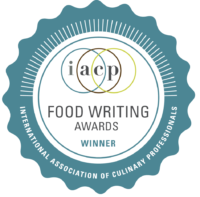Lately Himself has been trying to eat less meat, which is nigh impossible, seeing as how he’s my #1 date on these dining adventures. It’s not too difficult if we’re eating Asian, but Polish food is particularly heavy on meat of all kinds. As we made our way to Polka in Glendale, I wondered if the meat-and-cabbage stereotype was just that, or if there was more to this cuisine.
As expected, there was plenty of meat and cabbage on the menu. But Himself found a vegetarian plate that included pierogis, large flour dumplings filled with mashed potatoes and cheese and palushki, little white football-shaped noodles made of potato and flour. They reminded me a bit of really large spaetzle, but without the egg. There was also a generous serving of sautéed mushrooms, which provide a nice meatiness and heft to the meal. He didn’t come away hungry from this meatless plate–but I’ll confess, since he might not, that he did pinch a couple of bites of my beef.
I went for a trio of Polish standards, gulasz, slow-cooked beef; golabki, cabbage roll stuffed with ground beef and onion; and the same pierogis filled with potatoes and cheese. My plate included a couple of those little creamy smooth palushkis, too. Rounded out with vegetables and a bowl of tomato soup, this was a meal best eaten in preparation for a full day of work–or a really long nap.

Every time I have cabbage rolls I’m surprised all over again by how much I love them. As a child, I was okay with coleslaw, but I just didn’t like cooked cabbage. My aged grand-auntie loved boiled cabbage and tried to instill in me a liking for it, but it was pretty awful stuff. The mere sight of those limp, sickly pale green leaves sent waves of revulsion rippling through me. I was happy to discover as an adult that if you roll up some tasty food inside a cabbage leaf, blanket it in a coating of tasty sauce and cook it, it can be quite, well…tasty! In Poland, cabbage is called “the king of vegetables.” Considering its versatility and its ability to get people through a long, cold northern European winter, I’d say the title is well earned. It’s a cold-weather-happy vegetable that can be further kept until the next harvest by pickling. That’s where sauerkraut comes in.

Back home I made a whopping pot of bigos, a rich, meaty, mushroomy, krauty stew that I’m sure would have been even better if I’d slow cooked it on a cold, winter’s day and luxuriated in the heat it provided for the house. Instead I faced August’s triple-digit nightmare with the oven turned on. No matter. This was good stuff and worth the extra heat. I used beef, kielbasa and bacon, but from everything I’ve heard and read, the more types of meat you chuck into it, the better it is. And it’s reputed to be its best after several reheatings. This recipe makes a generous batch, so it’s easy to put this theory to the test. Himself and I will be eating on it for at least a week.
Bigos is made with sauerkraut, dried mushrooms and whatever meat is available from the hunt. In fact, the Poles call it “hunter stew,” because it was carried along for sustenance during the hunt, and they’d chuck into it bits of meat from whatever they’d bagged each day. It’s an all-purpose, popular meal that traditionally was made in a large quantity and kept in a wooden barrel. While it is especially popular during Lent and Christmas, it seems everyone eats bigos all the time. In fact, bigos is considered the national dish of Poland.

I’m including a photo of some pierogis from a demo of their production at the Polish Museum of America in Chicago, which has the largest concentration of Poles outside of Poland. These are so plump and lovely. We ate a lot of pierogis that day, some savory and some sweet. I’d never really thought about having sweet pierogis, but filled with lightly sweetened farmer’s cheese and topped with nuts and dried fruits and drizzled with honey or a light syrup, pierogis are a good dessert as well as main course. It makes perfect sense.
Now, about that stereotype. Yes, Polish food is heavy on meat and cabbage, along with potatoes, mushrooms and milk products. These foods have been its staples for a very long time, and with good reason. Given the lack of outside influences between the end of World War II and the collapse of communism in Poland in 1989, this country has been a sort of time capsule of foods. While foods from the rest of the world–and fast foods–are available there now, they don’t seem to factor into what is considered authentically Polish. Not yet, anyway.

















